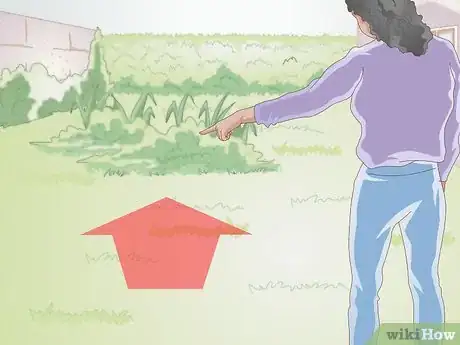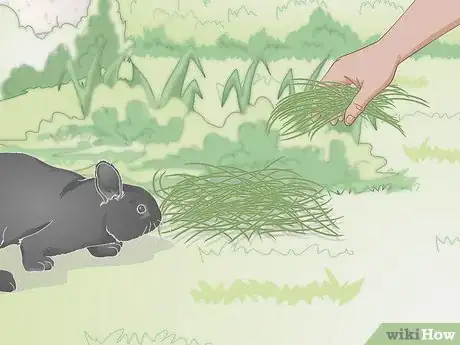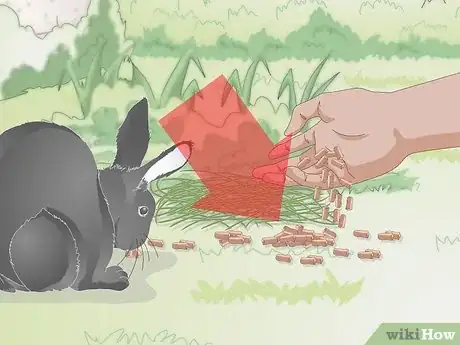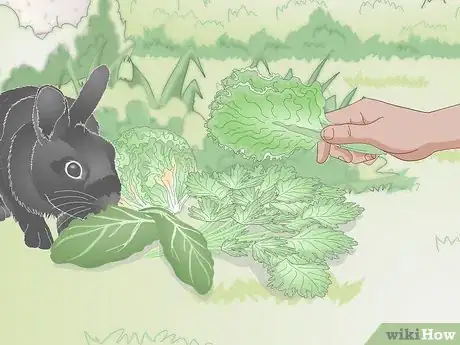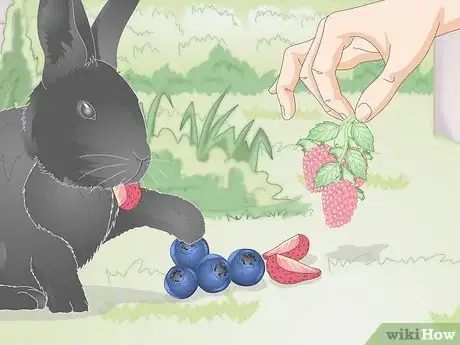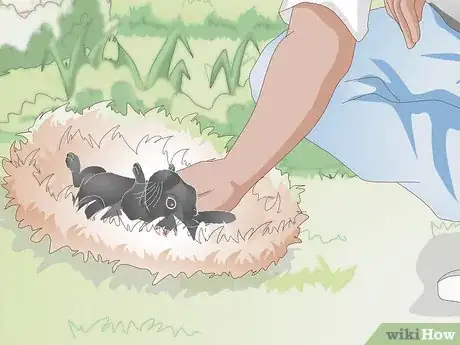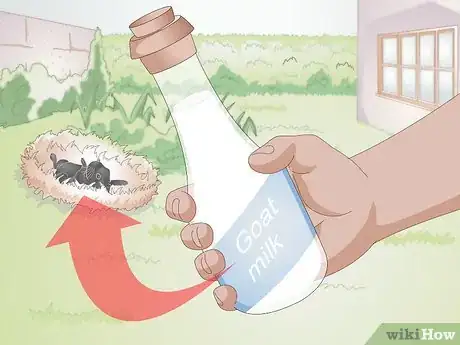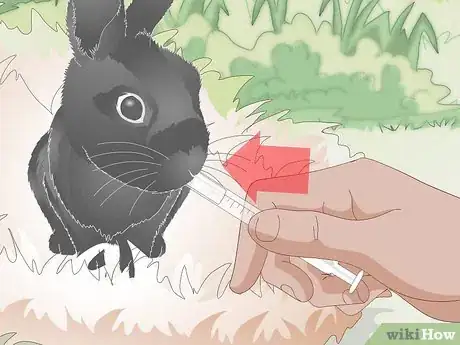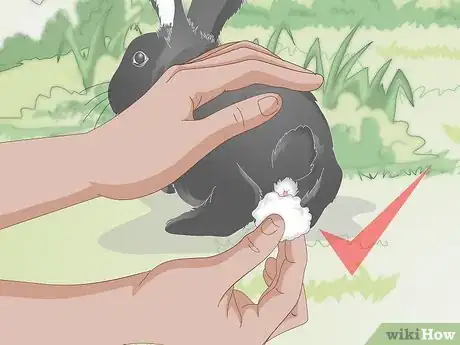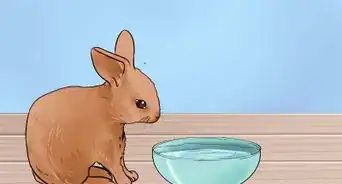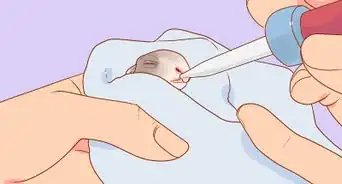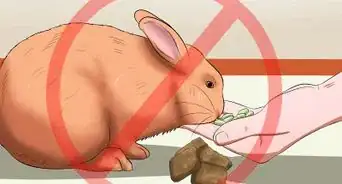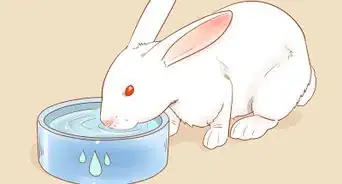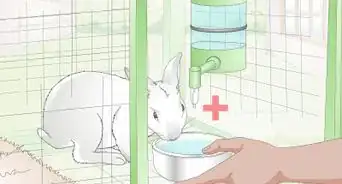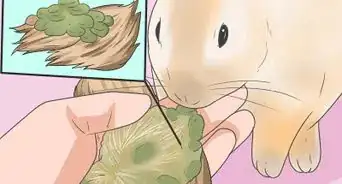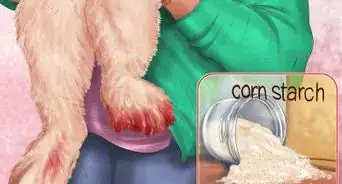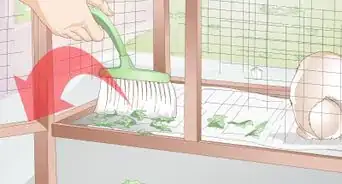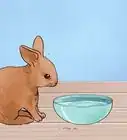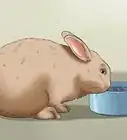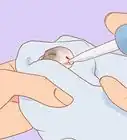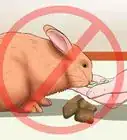This article was co-authored by Pippa Elliott, MRCVS. Dr. Elliott, BVMS, MRCVS is a veterinarian with over 30 years of experience in veterinary surgery and companion animal practice. She graduated from the University of Glasgow in 1987 with a degree in veterinary medicine and surgery. She has worked at the same animal clinic in her hometown for over 20 years.
There are 8 references cited in this article, which can be found at the bottom of the page.
wikiHow marks an article as reader-approved once it receives enough positive feedback. This article received 38 testimonials and 95% of readers who voted found it helpful, earning it our reader-approved status.
This article has been viewed 778,697 times.
If you see a wild rabbit in your yard, you may want to start feeding it. Before you go outside with a handful of carrots and lettuce, though, it is important for you to know what to feed a wild rabbit, and if you should try to feed it at all (especially if it’s a baby rabbit). Although feeding wild animals is generally not recommended,[1] knowing what and how to feed a wild rabbit will at least ensure that you are not doing more harm than good.
Steps
Feeding an Adult Wild Rabbit
-
1Choose a spot in your yard to place the food. If you do not mind wild rabbits visiting your yard, you can create an area of your yard where the wild rabbits can eat. Since wild rabbits tend to like wooded or shrubby areas on the edges of a particular area,[2] consider creating a small brush pile near the edge of your yard or garden for the wild rabbits.
- In the summer, when rabbits like to eat grasses and weeds, leave an area of your lawn partially uncut—this allows grass and/or weeds to grow up,[3] and can also provide a sheltered area for the wild rabbits to eat.
- If the wild rabbits feel safe in your yard, do not be surprised if they eat grass all day.
- During the colder months, when rabbits eat more barks and twigs, you can make a small pile of these items in a corner of your yard.[4]
- Be aware that placing food in these spots could attract other wild animals to your yard.[5]
-
2Provide the wild rabbits with grass and hay. Whether wild or domesticated, grass and hay are staples of a rabbit’s diet.[6] The wild rabbits in your yard will have an abundance of grass to chew on, but will probably not have ready access to hay. The recommended types of hay for wild rabbits are oat, and timothy. Alfalfa hay should only be given to older rabbits. Avoid giving adult rabbits alfalfa, as it is too high in protein, calcium, and sugar.[7]
- Visit your local pet store or feed store to purchase the hay.
- Do not spray pesticides in your yard in which you are feeding wild rabbits. The pesticides could make the wild rabbits very sick.[8]
Advertisement -
3Place pelleted rabbit food out for the wild rabbits. Pellets are a great nutritional source for rabbits. Pellets with seeds are ideal for wild rabbits.[9] Keep in mind that pellets tend to be very nutrient dense—you do not need to feed them in large quantities.[10]
- Look for pellets at your local pet store. If you can approximate the sizes of the wild rabbits, you could ask the staff at the pet store about an adequate amount of pellets to feed the rabbits.
-
4Give the wild rabbits fresh vegetables. Give them at least three different types of greens per feeding, and including one that is high in vitamin A. For the wild rabbits in your yard, you can give them:
- Collard greens (high in vitamin A)
- Beet greens (the tops, high in vitamin A)
- Lettuce: Romaine, Red or Green leaf (no iceberg or light colored leaf)
- Spinach
- Parsley
- Basil
- Mint
- Bok Choy
- Dandelion leaves
- Mustard greens
- Pea pods (just the pods)
- Brussels sprouts
- Swiss chard
- Broccoli (the leaves and stems)
- Cilantro
- Dill
- The green part of carrots
- Celery leaves
- Watercress[11]
- Thoroughly rinsed carrot tops are another good vegetable option.[12]
- Thoroughly rinse all vegetables to remove pesticides.
- Although carrots are a very popular food for rabbits, they are high in carbohydrates and should only be fed in small quantities(only half a carrot every other day).[13] Feed the wild rabbits a smaller amount of carrots than the other vegetables.
- Do not feed the wild rabbits vegetables that can cause gas or bloating: broccoli, cauliflower, and cabbage. Since rabbits are unable to pass gas, the buildup of gas in their digestive systems can cause serious health issues and may even be fatal.[14]
- Because wild rabbits are not as acclimated to vegetables as domesticated rabbits, introduce them to vegetables slowly.[15] Try feeding them just one type of vegetable at a time.Begin with only a small amount of a green, and watch for any intestinal issues in your bunny, such as diarrhea or soft stools.[10]
- Rabbits also have individual likes and dislikes when it comes to taste so if your bunny isn’t interested in a certain vegetable, make note of it and replace it with a vegetable he/she might prefer.
- Wild rabbits can get diarrhea if they are introduced to new vegetables too quickly.
- Wild rabbits also enjoy eating clover and watercress.[16]
-
5Provide the wild rabbits with small amounts of fruit. Wild rabbits will eat small berries, but will also eat other plant parts to balance off the fruit’s high sugar content.[17] If you would like to give fruit to the wild rabbits, consider giving them different types of berries: blueberries, raspberries, strawberries, and blackberries.[18]
- For raspberries and blackberries, provide the wild rabbits with the fruit as well as the plant stems and leaves.
- Bananas and dried fruit are very high in sugar and should be fed only sparingly (even less than the other fruits). Per rabbit, one to two half-inch slices of bananas and two to three pieces of dried fruit would be enough.[19]
- Other types of fruit you could feed the wild rabbits include papaya, honeydew melon, and plums (without the pit). However, you may want to stick with the berries, since the rabbits may be more accustomed to eating these in their natural environment.
Feeding an Orphaned Baby Wild Rabbit
-
1Determine if the baby wild rabbit is truly an orphan. If you find a nest of baby wild rabbits and the mother is not around, or if you see tiny baby wild rabbits hopping around on their own, you may think they are orphans. More times than not, however, this is not the case—their mother is simply not at the nest and will return later. It would be better for you to be certain whether the babies are orphans before attempting to feed and care for them.
- Wild rabbit mothers nurse for short periods during the night and early dawn, then leave the nest during the day.[20] Therefore, it would not be surprising if you did not see the mother with her babies during daytime hours.
- If the babies’ tummies look nice and plump, you can be confident that their mother is caring for them. If you look closely at their bodies, you may be able to see a ‘milk line’ through their skin—evidence of nursing.[21]
- If you want to be sure the mother is around, you can place string in a grid pattern over the nest.[22] Arrange the string in the evening and check it in the morning. If it is disturbed, then the mother has returned to the nest.
- Baby wild rabbits who appear cold, weak, dehydrated (loose skin stays tented when you pinch it), or injured are likely orphaned.[23] Since baby wild rabbits are extremely difficult to rehabilitate and care for,[24] you should contact a wildlife rehabilitation center as soon as possible. [25]
-
2Learn what to feed orphaned baby wild rabbits. In the event that you are not able to get to a wildlife rehabilitation center right away, you may need to provide at least initial care (food, general comfort) to the orphaned baby wild rabbits. Regular goat milk is frequently recommended for baby wild rabbits.[26] Kitten and puppy milk replacers are also good choices.[27] [28]
- Milk replacers are available at your local pet stores.
- You may be able to find regular goat milk at your local grocery store. If it is not available there, ask the grocer where you can find it.
- Cow’s milk and human baby formula (Pedialyte) are not recommended for feeding baby wild rabbits.[29]
- If the baby wild rabbits are cold prior to you feeding them, warm them up by placing them in a shoebox lined with a clean, soft cloth. Set a heating pad on low and set in a tabletop. Place the shoebox halfway on the heating pad—this will allow the babies to move away from the heat if they become too warm.[30]
-
3Feed the baby wild rabbits. Knowing what to feed baby wild rabbits is only half the battle—knowing how to feed them is a crucial component to their survival. Because they are so small, baby wild rabbits can be fed with a syringe (one to three milliliters), which is available at your local pharmacy.[31] [32] Eyedroppers are another good option.[33]
- To remove harmful bacteria from the milk or formula, warm them up in the microwave or boil them on the stove.[34] Cold milk or formula could cause potentially fatal diarrhea in baby wild rabbits.[35]
- Keep the feeding area quiet so as not to stress the babies.[36]
- One at a time, gently pick up each baby wild rabbit and hold him loosely but firmly in a soft cloth. Tilt his head so that it is higher than his back end and place the syringe near the side or bottom of his mouth—these two actions will prevent him from accidentally inhaling the liquid down into his lungs.[37] [38]
- Do not overfeed the baby wild rabbit. You will know when to stop feeding when his tummy becomes slightly rounded.[39]
- Visit the website http://www.orphanedwildlifecare.com/rabbitandhare.htm to know how much to feed, and how often, according the baby wild rabbits’ ages.
- Make sure to wash your hands before each feeding session.[40]
-
4Stimulate urination and defecation. After the baby wild rabbits have finished eating, it is important for them to urinate and defecate to keep their digestive and urinary systems healthy. To do this, stroke the anal area with a cotton ball moistened with warm water until the rabbit urinates and defecates.[41]
Expert Q&A
-
QuestionWhat do wild cottontail rabbits like to eat?
 Pippa Elliott, MRCVSDr. Elliott, BVMS, MRCVS is a veterinarian with over 30 years of experience in veterinary surgery and companion animal practice. She graduated from the University of Glasgow in 1987 with a degree in veterinary medicine and surgery. She has worked at the same animal clinic in her hometown for over 20 years.
Pippa Elliott, MRCVSDr. Elliott, BVMS, MRCVS is a veterinarian with over 30 years of experience in veterinary surgery and companion animal practice. She graduated from the University of Glasgow in 1987 with a degree in veterinary medicine and surgery. She has worked at the same animal clinic in her hometown for over 20 years.
Veterinarian Wild rabbits thrive on a diet of different types of herbage such as shoots and leaves from a variety of wild plants and grasses. In the winter months, they eat evergreen needles, bark, and any remaining green plants. Contrary to popular belief, they rarely dig up carrots and other root vegetables but are more likely to eat the leafy tops.
Wild rabbits thrive on a diet of different types of herbage such as shoots and leaves from a variety of wild plants and grasses. In the winter months, they eat evergreen needles, bark, and any remaining green plants. Contrary to popular belief, they rarely dig up carrots and other root vegetables but are more likely to eat the leafy tops. -
QuestionWhat do you feed a wild baby rabbit?
 Pippa Elliott, MRCVSDr. Elliott, BVMS, MRCVS is a veterinarian with over 30 years of experience in veterinary surgery and companion animal practice. She graduated from the University of Glasgow in 1987 with a degree in veterinary medicine and surgery. She has worked at the same animal clinic in her hometown for over 20 years.
Pippa Elliott, MRCVSDr. Elliott, BVMS, MRCVS is a veterinarian with over 30 years of experience in veterinary surgery and companion animal practice. She graduated from the University of Glasgow in 1987 with a degree in veterinary medicine and surgery. She has worked at the same animal clinic in her hometown for over 20 years.
Veterinarian First, be certain the rabbit needs rescuing. Remember the mother only feeds her babies for a short time twice a day. If the mother is dead, then offer Kitten Replacement milk feed from a dropper.
First, be certain the rabbit needs rescuing. Remember the mother only feeds her babies for a short time twice a day. If the mother is dead, then offer Kitten Replacement milk feed from a dropper. -
QuestionWhat's the best bedding for a baby jackrabbit?
 Pippa Elliott, MRCVSDr. Elliott, BVMS, MRCVS is a veterinarian with over 30 years of experience in veterinary surgery and companion animal practice. She graduated from the University of Glasgow in 1987 with a degree in veterinary medicine and surgery. She has worked at the same animal clinic in her hometown for over 20 years.
Pippa Elliott, MRCVSDr. Elliott, BVMS, MRCVS is a veterinarian with over 30 years of experience in veterinary surgery and companion animal practice. She graduated from the University of Glasgow in 1987 with a degree in veterinary medicine and surgery. She has worked at the same animal clinic in her hometown for over 20 years.
Veterinarian Good quality hay is the best choice, since hay is not only a good insulator to keep the rabbit warm, but is a food source. Thus, if the rabbit is too scared to come out to get food, it has a source of nutrition in its bedding.
Good quality hay is the best choice, since hay is not only a good insulator to keep the rabbit warm, but is a food source. Thus, if the rabbit is too scared to come out to get food, it has a source of nutrition in its bedding.
Warnings
- Not knowing how to properly rehabilitate and care for an orphaned baby wild rabbit can do more harm than good.[44] Transfer the care of the orphaned rabbits to the nearest wildlife rehabilitation center as soon as possible.⧼thumbs_response⧽
- Pesticides are toxic to wild rabbits.[45]⧼thumbs_response⧽
- Certain vegetables (e.g., broccoli) can cause potentially fatal gas and bloating in wild rabbits.[46]⧼thumbs_response⧽
- Unless you are licensed by your state’s Department of Environmental Protection, it is illegal for you to keep and care for a wild animal.[47]⧼thumbs_response⧽
References
- ↑ http://cwf-fcf.org/en/about-cwf/contact-us/faq/faqs/we-noticed-a-wild-rabbit-in.html
- ↑ http://cwf-fcf.org/en/about-cwf/contact-us/faq/faqs/we-noticed-a-wild-rabbit-in.html
- ↑ http://cwf-fcf.org/en/about-cwf/contact-us/faq/faqs/we-noticed-a-wild-rabbit-in.html
- ↑ http://cwf-fcf.org/en/about-cwf/contact-us/faq/faqs/we-noticed-a-wild-rabbit-in.html
- ↑ http://cwf-fcf.org/en/about-cwf/contact-us/faq/faqs/we-noticed-a-wild-rabbit-in.html
- ↑ http://www.healthguidance.org/entry/11706/1/What-Kind-of-Food-Do-Wild-Rabbits-Eat.html
- ↑ http://www.indianahrs.org/rabbit-care/wild-rabbits.aspx
- ↑ http://www.healthguidance.org/entry/11706/1/What-Kind-of-Food-Do-Wild-Rabbits-Eat.html
- ↑ http://www.healthguidance.org/entry/11706/1/What-Kind-of-Food-Do-Wild-Rabbits-Eat.html
- ↑ http://www.healthguidance.org/entry/11706/1/What-Kind-of-Food-Do-Wild-Rabbits-Eat.html
- ↑ http://www.healthguidance.org/entry/11706/1/What-Kind-of-Food-Do-Wild-Rabbits-Eat.html
- ↑ http://www.indianahrs.org/rabbit-care/wild-rabbits.aspx
- ↑ http://www.humanesociety.org/animals/rabbits/tips/rabbit_fruit.html
- ↑ http://www.healthguidance.org/entry/11706/1/What-Kind-of-Food-Do-Wild-Rabbits-Eat.html
- ↑ http://www.healthguidance.org/entry/11706/1/What-Kind-of-Food-Do-Wild-Rabbits-Eat.html
- ↑ http://www.healthguidance.org/entry/11706/1/What-Kind-of-Food-Do-Wild-Rabbits-Eat.html
- ↑ http://www.humanesociety.org/animals/rabbits/tips/rabbit_fruit.html
- ↑ http://www.humanesociety.org/animals/rabbits/tips/rabbit_fruit.html
- ↑ http://www.humanesociety.org/animals/rabbits/tips/rabbit_fruit.html
- ↑ http://www.2ndchance.info/bunnies.htm
- ↑ http://www.2ndchance.info/bunnies.htm
- ↑ http://www.humanesociety.org/animals/rabbits/tips/solving_problems_rabbits.html
- ↑ http://www.2ndchance.info/bunnies.htm
- ↑ http://www.2ndchance.info/bunnies.htm
- ↑ http://hopline.org/rabbit-health-and-care/what-do-i-do-if-i-find-a-wild-rabbit/
- ↑ http://www.indianahrs.org/rabbit-care/wild-rabbits.aspx
- ↑ http://www.orphanedwildlifecare.com/rabbitandhare.htm
- ↑ http://www.indianahrs.org/rabbit-care/wild-rabbits.aspx
- ↑ http://www.orphanedwildlifecare.com/rabbitandhare.htm
- ↑ http://hopline.org/rabbit-health-and-care/what-do-i-do-if-i-find-a-wild-rabbit/
- ↑ http://www.indianahrs.org/rabbit-care/wild-rabbits.aspx
- ↑ http://www.orphanedwildlifecare.com/rabbitandhare.htm
- ↑ http://www.indianahrs.org/rabbit-care/wild-rabbits.aspx
- ↑ http://www.2ndchance.info/bunnies.htm
- ↑ http://www.orphanedwildlifecare.com/rabbitandhare.htm
- ↑ http://www.orphanedwildlifecare.com/rabbitandhare.htm
- ↑ http://www.indianahrs.org/rabbit-care/wild-rabbits.aspx
- ↑ http://www.2ndchance.info/bunnies.htm
- ↑ http://www.2ndchance.info/bunnies.htm
- ↑ http://www.2ndchance.info/bunnies.htm
- ↑ http://www.indianahrs.org/rabbit-care/wild-rabbits.aspx
- ↑ http://www.healthguidance.org/entry/11706/1/What-Kind-of-Food-Do-Wild-Rabbits-Eat.html
- ↑ http://www.humanesociety.org/animals/rabbits/tips/solving_problems_rabbits.html
- ↑ http://hopline.org/rabbit-health-and-care/what-do-i-do-if-i-find-a-wild-rabbit/
- ↑ http://www.healthguidance.org/entry/11706/1/What-Kind-of-Food-Do-Wild-Rabbits-Eat.html
- ↑ http://www.healthguidance.org/entry/11706/1/What-Kind-of-Food-Do-Wild-Rabbits-Eat.html
- ↑ http://hopline.org/rabbit-health-and-care/what-do-i-do-if-i-find-a-wild-rabbit/
About This Article
To feed a wild rabbit in your yard, choose a wooded or shrubby area where a rabbit will feel safe and scatter plenty of grass and hay there. You can supplement the grass and hay with a small amount of pelleted rabbit food from a pet store, but avoid feeding wild rabbits too much, since pellets are very nutritionally dense. You can also give them leafy greens like lettuce, spinach, and Swiss chard! To learn how to feed an orphaned baby rabbit, read on!
